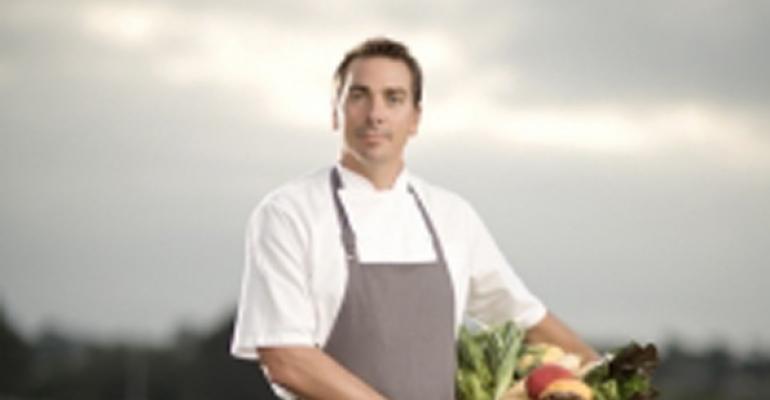Rancho Valencia resort and spa, originally built in 1989 in the San Diego suburb of Ranch Santa Fe, reopened at the end of October after a $30 million transformation. Chef Eric Bauer is heading up the food at the 49-suite resorts' two restaurants — a casual modern American eatery called The Pony Room and a more upscale Mediterranean restaurant called Veladora — as well as at the spa.
Chef Bauer most recently ran the kitchen at Anthology in downtown San Diego, where he was known for his locally influenced cuisine. At Rancho Valencia, he's taking local to a new level with plans to use honey that he collects from the property’s six beehives and ages in bourbon barrels. He's also making his own charcuterie for the restaurants and preparing upscale ice pops called “spasicles,” with flavors such as Champagne-lemon.
Bauer recently spoke with Nation’s Restaurant News about the culinary ideas and techniques he brings to Rancho Valencia's restaurants.
RELATED
• Chef Sam Gorenstein on the Miami seafood scene
• Chef Trey Foshee highlights vegetables at George's at the Cove
• More food and beverage news
What’s the food like at the Pony Room?
It’s seasonal, rustic American cuisine. So we’re serving dishes that are done simply and serving them on things like reclaimed wine barrel boards, cast iron, slate.
What’s an example?
We’re taking different types of cauliflower cut up, tossed with olive oil and salt, thrown in the wood-fired oven, and that’s it.
The Pony Room’s also one of the first places on the West Coast with Prosecco on draft. And we have our own white and red blends that we do with some winemakers in the northern part of the county.
I understand you also have 100 types of tequila?
Yes. We also have these tequila tasting mats, and we’ll sit down and do tequila classes. That came about from the owners, who are very big on tequila; they love it. We figured, why not do tequila tastings like a wine tasting class and rate the clarity and viscosity and amount of agave that’s in it.
How about Veladora?
It’s a Mediterranean restaurant; it means wooden candle in Spanish.
We do octopus carpaccio with smoked potatoes, a little butter olive pesto, pickled sweet peppers from a local farm, and some really nice Spanish olive oil.
What’s a butter olive?
It’s an olive from Spain — really bright, bright green but very creamy. We basically puree that with a little chive and chile flake, olive oil and a touch of roasted garlic.
You also have beehives on site. How long does it take a bee to make honey?
It takes a little while to get the hive going. Then you can basically take honey every month. The hives have been there for about eight months, and our first harvest will be in December. We put the hives in our olive grove — some of the best honey in the world comes from olive groves — and hopefully it’ll help to pollinate those trees even better so we can possibly make our own olive oil. And we’ll cure our own olives for sure.
Another part of our focus is on healthy cuisine. So we’re bringing back ancient grains like millet and quinoa and farro.
We have a great millet dish with Scottish trout, mussels, fennel, orange reduction, chile flake and a little limoncello.
We’re doing a ton of smoking vegetables right now, too. A lot of our dishes have vegetables that have been done two different ways — smoked and pureed or raw and smoked or raw and pureed — so you give people a couple of different aspects of vegetables like turnips or radishes.
Are the pureed vegetables just poached first?
Most every vegetable on our menu, if it’s cooked, it’s cooked in a vegetable stock, so if a vegetarian comes in, I haven’t used chicken stock to cook the vegetables. We poach them really lightly and then shock them really quickly in a blast chiller and then puree them.
Do you use the blast chiller so you don’t have to rinse them?
Exactly. That’s probably my favorite piece of equipment in my kitchen, because you can retain the flavor of the vegetables. If you cook green beans and then drop them in ice water they suck up more water [and lose some of their flavor].
I also can make some huge ice cubes. We’ve got a cold draft ice machine to make one-and-three-quarter-inch cubes, and then we have molds to make even bigger cubes for our nice Scotches.
Tell me about spasicles. Are they better for you than Popsicles?
A lot of them are all juice, sweetened with agave instead of sugar, so yeah, they’re better for you. But they’re still Popsicles. We’re also going to do vegetable flavors, and we use a slow corkscrew juicer, so it tastes better and it has more nutrients.
How does a corkscrew juicer work?
Instead of having a blade that goes down and is spinning fast and heating up the vegetables, you’re pressing them through the corkscrew and pushing out the fiber, and then we actually take the fibers, dehydrate them, grind them up and use them in different dishes in the spa.
Contact Bret Thorn at [email protected].
Follow him on Twitter: @foodwriterdiary





